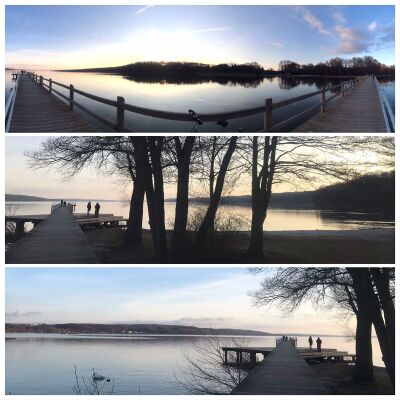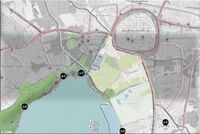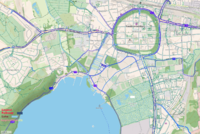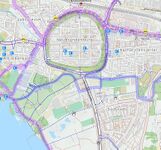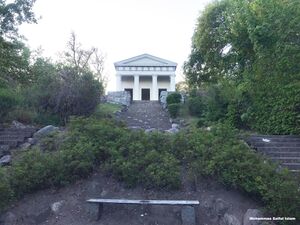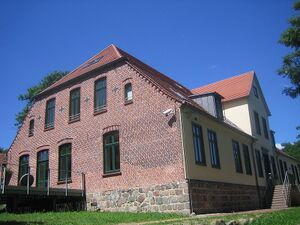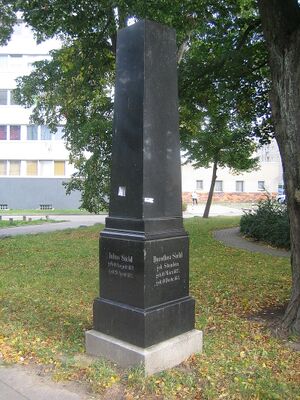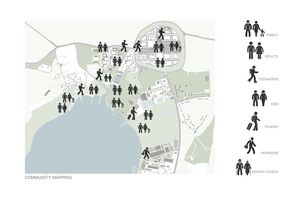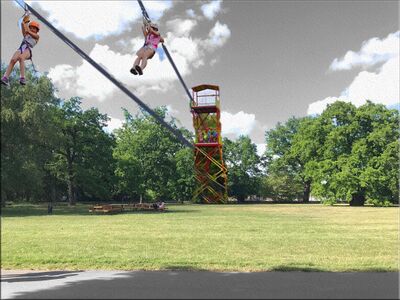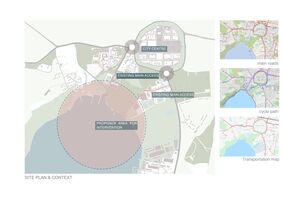WAVE Living Lab Neubrandenburg 2022
>>>back to working groups overview
Rationale
- The water area in Neubrandenburg is the main attraction of the city. Especially the Tollensesee lake is the main lake in the city which has a rich cultural and strategical history. Since the water area in the city is the main attraction of it, the number of people around the lake is increasing by doing different activities. As an illustration, water sports such as boating, swimming and other outdoor activities such as, volleyball and Frisbee at the beach, walking and cycling around the lake and the cultural park. .And since the goal for this WAVE seminar is maintenance territories in a sustainable way. Especially the places which are relevant to the society and the economy. The Tollensesee considers an important part of everyone who live in Neubrandenburg since most of the activities in the city take place by the lake.
Location and scope
You can edit this map with the map editor
Water as a natural system
Geomorphology, typologies and dynamics of water areas
Tollense Lake is a lake in Mecklenburg-Western Pomerania, Germany, southwest of the city of Neubrandenburg. It is 11 kilometers long and 2.5 meters wide. Tollense Lake is located in an ice age tunnel valley and has a surface size of 17.350 km2 and a depth of 34 meters.
The environment near the Tollense lake was made up of chains of hills, sand plains, streams, and lakes during the Ice Age. The name Tollense comes from the Slavic word "dolenzia," which meaning "lowland." For a long time, the landscape area around Tollense Lake has been known as a glacier tongue basin. Tollense Lake is a particularly important water region in Neubrandenburg. It joins the Tollense River, a right-hand tributary of the Peene River. The river goes from Peene River to Szczecin Lagoon and Achterwasser, which offers direct access to the Baltic Sea. Blumenholz is a small settlement located southwest of Tollense Lake. Mürzsee is the upstream beginning of the Tollense River in Blummenholz. A river called Zimmenbach feeds into Lieps Lake from Mürzsee. Alter Graben River flows from Lieps Lake to Tollense Lake from Lieps Lake. Oberbach and lmühlenbach are two branches that run into Tollense River from Tollense Lake. After around 1.6 kilometers, both branches come together.
The Nonnenbach stream of the Tollense Lake is the longest and most water-rich, while the Tollense River has tributaries such as Lindebach. Due to its flow reaching the Lindetal district, east of Neubrandenburg, Lindebach is one of the significant tributaries. The Datze river, which flows north of Neubrandenburg, Torneybach, Gold Bach, Großer Landgraber, and Augraben river, all of which are close to Demmin, are important tributaries of Tollense River. The floodplains of Tollense Lake and Tollense River are plotted largely near to part of the city's constructed area, according to Mecklenburg Vorpommern's Geoportal website.
Neubrandenburg had a population of 10,500 people in 1900. In 1958, it had a population of 30,449 people. The built area to the northeast of Tollense Lake was developed in 1991. The constructed area has now expanded to the east and northwest of Tollense Lake. To summarize, green areas still dominate Tollense Lake's south, southeast, and southwest portions. Around the lake, facilities like as passenger boats, restaurants, cafes, a bicycle path, and bathing areas have been built to meet the modern demands of locals and tourists.
No floods have been recorded around Lake Tollensesee and the River Tollense. However, there is a potential risk of flooding because of the climatic change and increase in water level. Water levels in this area have been rated from normal to high and have not yet reached warning levels.
- Index.php?title=File:Index.php?title=File:Index.php?title=File:Yourcase watersystem1.jpg
add a caption
- Index.php?title=File:Index.php?title=File:Index.php?title=File:Yourcase watersystem3.jpg
add a caption
Water as a living space
The surroundings and Lake Tollensesee are filled with a variety of plant species and a variety of organisms. Some of the plants species which is seen nearby the lake are Downy birch, horse and sweet chestnut, Juniper, European Larch, Juniper, Black Locust, European Wild Apple, Cherry, Elm, European Beech, Ash, Hazel, Spruce, Alder, Pine tree, Willow, Mursh Marigold, Marine plants(like Elodea Canadensis ) and etc. The lake is also enriched with varieties of habitats European Perch, common Rudd, Vimba Bream, Blicca Bjoerkna, and Trout), waterfowl and frogs. The tourists and travelers can see various types of animals in the south or southeast of the lake like squirrels, rabbits, foxes, boars, etc.
The Tollense River has water quality improvement factors such as forested areas, agricultural land, and man-made dams to regulate water balance, moderate temperatures, and biodiversity. The presence of dense vegetation nearby increases the oxygen content of the river.
Studies have shown that the temperature of water containing large amounts of dissolved oxygen is considered to be between 32 and 86 degrees Fahrenheit. Observing the average weather data for Neubrandenburg, the temperature readings from March to November were satisfactory. Dissolved oxygen levels (oxygen solubility decreases as water temperature increases) and water density and stratification (water density is highest at 39 degrees Fahrenheit. Differences in temperature and water density between the water layers of a lake cause stratification and seasonal exchanges). The various aquatic plants present in the Tollense River can increase the transparency of the water as it can use nutrients that would otherwise be used by algae. They can absorb contaminants from contaminated water. Visual inspection of Lake Tollense showed that the water was clear enough to see aquatic fish and aquatic habitats and clean enough for people to use for swimming and other recreational activities. There are currently no signs of waste disposal or other water polluting activities on or off Lake Tollense.
- Your case green blue infrastructure1.jpg
add a caption
- Your case green blue infrastructure2.jpg
add a caption
Blue and Green Infrastructure
- What are the major potential elements of a green/blue infrastructure network? Are these likely to change/disappear? Why is that?
- You find my background material on green infrastructure in our reading list
- add 1-2 graphical representations to the image gallery, you can add more if you like
- Your case green blue infrastructure1.jpg
add a caption
- Your case green blue infrastructure2.jpg
add a caption
Water as a Cultural space
Water Consumption & Land Use
- map the land uses along your water areas: settlements, infrastructure, agriculture, resource extraction, natural areas, energy production...
- describe in particular the historical evolution of land use pattern, please make use of historical maps.. In 1804 was built first cemetery outside the wall. By 1900 were built 316 houses outside the wall and started more intensive urban development of north and east districts of the Neubrandenburg city behind the wall. So before 20 century main pattern of land use was settlement with natural and agricultural areas. But after 1939 Neubrandenburg got military use districts: camp for prisoners of war in 1939, torpedo experimental station on Lake Tollensesee in 1941, by 1943 was built women’s concentration camp. In 1945 city center was destroyed by fire. And military districts stopped functionating. In 1953 Neubrandenburg becomes the district capital. Neubrandenburg city history starts from 1170. In 1708 Neubrandenburg became something like capital of district that also can be considered as huge push for city development. To conclude, by now land use patterns of Neubrandenburg never changed significantly: settlements, agriculture and natural areas..
- description evolution, status quo and driving forces, is the land use likely to change? Why is that? `` Heritage, pleasure, tourism, nature-conservation, and education are the main driving elements at our Neubrandnburg construction site. Since the twentieth century, the city has grown dramatically, and our current working site in Neubrandenburg comprises of: residential areas, commercial areas, mixed-use areas, commercial areas, public amenities, green areas, water catchment zones, and sewage treatment zones.
- add 1-2 graphical representations to the image gallery, you can add more if you liken
Cultural and spatial typologies of water areas
- Which spatial patterns have evolved in relation to your water areas?
- Patterns in space One of the aspects that is regarded to be essential in understanding the history of the development and the kind of shape of these places is the study of spatial patterns of water in the areas referred to as water areas. In the case of Neubrandenburg, this research is focused on the historical section of the city (Altstadt), which is linked to the city's past but currently lacks any evidence of water. The presence of a major canal in a large circular configuration surrounding the old section of the city is plainly discernible.
- What is the role of water areas within the overall urban morphology? (approx 200 signs)
The importance of water regions in the overall morphology of cities
- Hill chains, sandy regions, many streams, and smaller lakes are particularly noteworthy characteristics of this ice age environment, which was developed during the last ice age, in the final 15,000 years of the Vistula Cold Age, and the succeeding warming phase (ice-free era for around 10,000 years).
- Premonstratensian monks from Broda Abbey, a monastery on the coast, were the first Christian monks in the region (about 1240). The city of Neubrandenburg was founded in 1248 by the Margrave of Brandenburg, who decided to build a settlement in the northern part of his fief and named it after the older city of Brandenburg, which was located further south. The city and its environs were annexed by Mecklenburg in 1292.
- The Slavic word "dolenzia" was used to name the lake (low point). The Slavic word "dolenzia" was used to name the lake (low point). For generations, Slavic tribes have been drawn to the quantity of fish. Around the lake, there are also educational facilities, tourism attractions, and business operations, among other things. When compared to many other cities, the population growth surrounding the lake appears to be minor, according to accessible maps. Protected woods, active agriculture, road networks, transit amenities, and the possibility of national tragedies might all be contributing factors to population increase distant from the lake.
- add 1-2 graphical representations to the image gallery, you can add more if you like
Sacred spaces and heritage
Fischer Island
Fischer Island is a small island off the coast of Tollense Lake
Fisher Island is a tiny island off the coast of Penzlin, near the southwest corner of Tollense Lake. The island is 150 meters long, 40 meters broad, and is now vegetated. A fishing cabin was erected in the centre of the island in 1729 and was still used by fishermen who stayed the night in 1970. The Slavic tribe Veleti-Rethra was said to have their headquarters on the island. The Archeologist discovered a figurine of Lel and Polel in 1969. It is a cult dedicated to the Slavic mythology's twin deities. In 1977, a German archaeologist named Hartmut Boeck uncovered a 40m x 14m rectangular area in the Northeastern Island.
Belvedere
On the north coast of Tollense Lake, you'll find Belvedere.
Adolf Friedrich IV, Duke of Mecklenburg-Strelitz, erected a vacation residence on a hill in 1775. It had been demolished up until that point. Grand Duke Marie, on the other hand, erected a Greek temple-style summer palace here in 1823. Wilhelm Buttel drew out the plans for the residence. The architect Heinrich Tessenow transforms Belvedere into a memorial for the Mecklenburg-Strelitz troops who died in the First World War in 1934. The structure was renovated as an open temple in 1995.
Broda Amtshaus
The Amthaus Broda is one of Neubrandenburg's oldest structures.
In roughly 1170, the Premonstratensian friars erected a monastery in In. In the years 1230 and 1240, the building took a long period. It is eventually turned into a manorial economy official dwelling Broda. This medieval structure was on the verge of collapsing in the 17th century. Amthouse Broda was renovated as a residential and office structure in the twentieth century. Hochschule Neubrandenburg used it as a hostel for international scientists starting in 2004.
The Alter Friedhof
The Alter Friedhof (alter Friedhof) is a place where you
The Alter Friedhof cemetery is located at Seestrasse, near the Tollense Lake. It is a peaceful and secluded place with graves fronting the Tollense Lake and the open Seeperle playground just in front of it, where families meet together and play with their children. The graves have just been restored and are situated in a large green space surrounded by huge trees that appear to protect the entire region.
- Index.php?title=File:Fisher Island.jpg
The Landscape Story and the Visual Appearance
- Which elements are essential for the landscape character?
A diversified and natural scenery characterizes the Tollense Lake and its environs. On all sides of the sea, beech and oak woodlands form a large protection area. Grasslands and reeds bring variety to the landscape and provide habitat for protected biotopes. The many pieces spread across a hilly area, creating a stunning scene. The lake itself has vast, open vistas, and its crystal-clear water can be seen from the flat shores.
- Has the landscape been painted or otherwise depicted, when and whom? Which elements are essential?
- Neubrandenburg has mentioned in a lot of artworks including the Tollense lake area which has considered as an inspiration element for some artists such as Caspar David Friedrich, Paul Flickel and Carl Gotthold Heinrich Arndt especially in the period between the middle of 17th and the early 20th century.
- The Tollense River, which flows from Neubrandenburg's Tollense Lake to Demmin's downstream end, and land usage in the Tollese River watershed from Klempenow to Demmin
- The city fortification of Neubrandenburg is "the most comprehensive example of a medieval city fortification in the brick construction area." The medieval city wall, which stretches for around 2,300 meters and is up to seven meters high, still entirely encloses the ancient city center. Four exceptional late Gothic city gates from the 13th to 15th centuries (Friedländer Tor, Stargarder Tor, Treptower Tor, and Neues Tor), several Wiekhäuser (guard houses), and the Fangelturm are encircled by the practically circular wall ring. Neubrandenburg is known as the "city of four gates" because of the wall and brick gates.
- The Franciscan monastery with St. Johannes monastery church, as well as the main parish church of St. Marien, consecrated in 1298, renovated by Friedrich Wilhelm Buttel after several fires in the 19th century, burned down in World War II, and converted into a concert hall from the 1970s to 2001, is now internationally renowned as a concert church.
Since its closure in the 1990s and subsequent restorations, the four-wheel mill has been home to a number of eating places.
- A 14th-century chapel dedicated to St. George.
Which narratives exist? Who has written about this landscape or depicted it in some way?
- You can add text and images
- Your case character1.jpg
add a caption
- Your case character2.jpg
add a caption
- Your case character3.jpg
add a caption
Water and People
Accessibility and usability
Accessibility
There is a great deal of accessibility to Tollense Lake. It has a network of pathways and roads that are not frequently interrupted. There are several beaches, playgrounds, a cultural park, and parking lots nearby. In addition to many footbridges, there are also many lookout towers that offer a better view. But there are some restricted areas nearby the lake, because of private houses and gardens. The canals in Neubrandenburg can also be widely accessed and used very effortlessly. The Tollense canal is partly unreachable because of private possessions.
Users
Tollense Lake focuses on water as the key element for bringing together all social groups. There is an attractive pole within the water area, where visual and physical connections are made, such as the bridge, where youth gather to talk, laugh, drink, and party. The culture park is also a place where families and friends walk and walk, some with pets while others feed pigeons and ducks; each space is utilized in an imaginative way, bringing nature and fluidity together. This is what makes the water area a huge attraction to the people of Neubrandenburg, and also to visitors. International students also use the lake to get to know one another. Several public areas come together at the water area to form a more stable connection to nature, water, and the city.
Community Mapping
Social groups: Tollense Lake provides a wide range of recreational and water sports activities for people of all ages, including children, teenagers, adults, and senior citizens. Near the lake, certain activities and attractions attract tourists, as well as families and elderly people living nearby. A lakeside environment is ideal for gathering and partying for students from the University of Neubrandenburg and other educational institutions. In the vicinity of the factory located on the southeast side of the lake, one can see a dense population of workers.
Local stakeholder groups: From the northwest to the northeast side of the city closer to the residential areas, there are around seven churches located within the perimeter of the Tollenese lakeside. There are a few community centers in the city, including venues for events and retirement communities. Several retail shops are located in the inner city and on the east side of the city.
External stakeholder groups: · Local authorities, such as government service units and political party offices, are located throughout the city. A number of other care services such as foster care, nursing homes, medical clinics, home health care, and elderly care are also available in the city.
- Index.php?title=File:Index.php?title=File:Sheet 4.jpg
Possible Futures
- Based on UN sustainable developments goals of Keeping the water clean, it’s predicted that by 2030 the water quality to be improved by reducing pollution, minimising the release of hazardous chemicals in the water and increase the safe reuse of the water. In the case of Tollensesee, there is some proposals to improve the water area. One of them is by reducing the amount of the interactive activities that occur in the water which can cause a lot of damage to the water area. Hence. Spreading awareness among the people would be the very first step into getting a healthy water environment. Using alternative transportation or parallel routes that can’t harm the water area or the creatures in or by the water would be a great sustainable for both the water area and the nature since it reduces the hazardous emissions which reflect positively on the environment and it would be a encouraging step for people to deal and use alternative behaviour towards the water.
- Index.php?title=File:Index.php?title=File:Index.php?title=File:Index.php?title=File:Index.php?title=File:Index.php?title=File:Index.php?title=File:IMAGE 1.jpg
This is a positive ecological scenario that aims to connect the people more with water not only just by walking around and enjoy the view but also by installing steps that plays the role of platforms to make a deep contact to the water area.
- Index.php?title=File:Index.php?title=File:Index.php?title=File:Index.php?title=File:Index.php?title=File:Index.php?title=File:Index.php?title=File:IMAGE 2.jpg
Another positive social scenario for the waterscape. Developing the old deck which not can only transfer the fishing area from the canal to the open sea but also give more freedom to the water sports in the canal and used also for such small gathering events.
- Index.php?title=File:Index.php?title=File:Index.php?title=File:Index.php?title=File:Index.php?title=File:Index.php?title=File:Index.php?title=File:Image 3.jpg
Although this way is considered as one of the important roads that connect the city with the water area, but it’s not well used to serve both the pedestrians and bike riders. That’s why we developed this road into a new one through creating a proper road that fits all the pedestrians and bike riders from both directions.
- Index.php?title=File:Index.php?title=File:Index.php?title=File:Index.php?title=File:Index.php?title=File:Index.php?title=File:Index.php?title=File:Image 4.jpg
A positive social scenario that simulates gathering people through converting a flat area and transforming it more dynamic area to fit the environment around. That solution shouldn’t only work in summer but also in all seasons .
- Index.php?title=File:Index.php?title=File:Index.php?title=File:Index.php?title=File:Index.php?title=File:Index.php?title=File:IMAGE 5.jpg
A positive social scenario that simulates gathering people through converting a flat area and transforming it more dynamic area to fit the environment around. That solution shouldn’t only work in summer but also in all seasons .
- Index.php?title=File:Index.php?title=File:Index.php?title=File:MOVABLE BOAT RESTAURANTS FOR VISITORS.png
The river Tollense has a magnificent region directly across from the community that few people visit. So the concept is to move from one side to the other, which is how the Movable Restaurants were born. The goal is to enjoy the lakeside while eating a meal, and people may take in the scenery. At the same time, they may optimize their time quality. This restaurant is situated between lakes, allowing the scenery of the lake to change at every moment. When people will engage with this type of activity, they will literally engage more with the water body .
- Index.php?title=File:Index.php?title=File:FLOATING WATER PURIFICATION PLANTS ON WATER BODY.jpg
This ecological scenario is located near some bank of Tollense lake. The Water quality can be harmed by numerous inorganic and organic contaminants on a daily basis. The approach of phytoremediation utilizing aquatic plants is the most desirable of the numerous solutions discovered thus far. Because of contaminating elements, aquatic habitats are under a lot of stress and depletion. Aqua plants are cost- effective and environmentally beneficial method of water. We may utilize the lakeside area or a specific location in Tollensee Lake to naturally clean the waterbody by employing floating aquatic plants such as Spirodela polyrhiza and Eichhornia crassipes to purify water bodies and maintain the water purification system.
On this positive Social scenario in the Kulturpark of the Tollensesee can focusing into the goal of social participation. For example, Some open fields may be seen between the trees in the 'Kulturpark' opposite the lake. As a result, our plan is to enforce certain activities in order to create some meeting areas. People may enjoy the park view from the top as well as the senario of this lake while 'Riding in the Rope' from one location to another in a matter of minutes by participating in this sort of activity. Rope riding may be a fun way to engage in cultural activities and social gatherings. People of all ages, especially those in the younger age groups, may benefit from this activity and come to enjoy a visit to this lake. This form of activity allows us to attract more.
Collaborative Goal Setting
- We are mainly pointing to two goals, ecological and social goals. The environmental or ecological goals are mainly associated with proposals more related to sustainability. And the social goals are the activities and designs that make people come together. The ecological goals combine multiple strategies: water purification, energy efficiency, and gardening. The water purification will be executed by providing various aquatic plants in the different areas of the lake that are mainly affected by pollution and proper care of the lake near the city. The idea of energy efficiency will be done with solar-powered street lights and water treatment. And gardening is the common name that is given to the flower gardens that are provided in the different parts of the lake that are unused.
- The social goals are more focused on our side to make the people more connected with the lake. Likely to ecological goals, socials are also divided into three, access, activities, and gathering spaces. The access to the lake from the city center is not that clear. From a tourist’s point of view, they don’t know where is this lake actually located. So providing better pedestrian pathways and bicycle paths from the city center make better transportation to the lake. By providing more signboards and signals, it will be clear to the newly coming tourists. Activities are the second on the list, we are trying the best and suitable activities that suites to the context of the lake. The space needs an iconic design proposal to attract people from other cities. So an elevated walkway that ends at a height of 40m will fill this gap. The walkway will be connected with stairs and elevators at various points of its path. Standing at a height of 40m and enjoying the scenic views will be a good adventure for all age groups peoples. The floating restaurant is another one that comes on this list. It makes people enjoy all around the lake not only the area related to the city center but also the other banks of the lake.
Spatial Strategy and Transect
- translate your strategic goals into a vision
- develop a spatial translation of your vision
- exemplify your vision in the form of a transect with concrete interventions
- add a map(s) and visualizations
From Theory of Change to Implementation
- For implementing your vision: Which partnerships are needed? Which governance model is required?
- Who needs to act and how? Draw and explain a change/process model/timeline
- Which resources are needed? On which assets can you build?
- add 150 wordof s text and visuals
References
- give a full list of the references you have used for your case
Process Reflection
- Reflect ionyour intercultural and interdisciplinary team on the outcomes of your study
- Which limitations were you facing?
- What have you learnt from each other?
- What did you learn in the Living Labs?
- What would you do differently next time?
- You can also use diagrams/visuals
- 250 words text
